By: Modest Mussorgsky
Week: 1
Modest Mussorgsky wrote 'Pictures at an Exhibition' in memory of his friend, Viktor Hartmann, who like Mussorgsky, died young at the age of 39. Each movement within the suite represents one of Hartmann's pictures. Mussorgsky used music to represent himself wandering the halls of a museum and stopping to look Hartman's pictures of gnomes, gardens, and markets. One meaning of 'promenade' is to take a leisurely walk, just as Mussorgsky envisioned himself doing in a museum during his 'Promenade' movement. Listen to the stately, soaring music, and imagine yourself entering a museum of high ceilings and graceful arches and gilded frames, as is pictured in 'Louis-Philippe Opening the Galerie des Batailles' by François Joseph Heim. What will you look at first? How about a painting of a gnome?
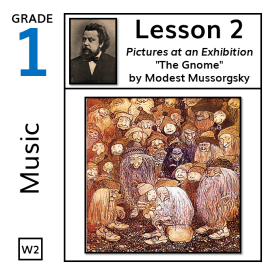
By: Modest Mussorgsky
Week: 2
Each movement within Modest Mussorgsky's 'Pictures at an Exhibition' reflects a picture. Mussorgsky used music to represent himself wandering the halls of a museum and stopping to look at pictures of gnomes, gardens, and markets. In stories, gnomes are often creatures of darkness that hoard sparking piles of treasure deep beneath the surface of the earth. Today, they are also the white haired, red cheeked, kindly old man statuettes that adorn people's gardens and lawns. Listen to the music. Which type of gnome do you think Mussorgsky envisioned? The artwork for this lesson is by John Bauer, showing a group of gnomes clustered around a little gnome boy who asks, 'How do I get into the mountain?' Next week, we'll move on to another painting of people enjoying a pleasant day in a garden.
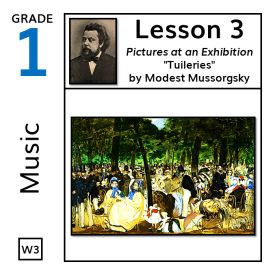
By: Modest Mussorgsky
Week: 3
Each movement within Modest Mussorgsky's 'Pictures at an Exhibition' reflects a picture. Mussorgsky used music to represent himself wandering the halls of a museum and stopping to look at pictures of gnomes, gardens, and markets. The Tuileries public garden, located in Paris, France, stretches between a public square and a museum, called the Louvre. The park has walkways and foliage and water basins and even a moat. Parisians meet there, play there, and promenade there. Look at the painting 'Music in the Tuileries' by Édouard Manet and listen to the music. Imagine yourself in the painting, mingling with the native Parisians. Is the music scary and dark? Is the music happy and light? Does the music match what you see in the painting? Why or why not? Okay, ever onward. Do you like animals? Great, because next week we'll look at a painting of an ox.
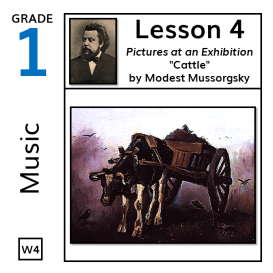
By: Modest Mussorgsky
Week: 4
Each movement within Modest Mussorgsky's 'Pictures at an Exhibition' reflects a picture. Mussorgsky used music to represent himself wandering the halls of a museum and stopping to look at pictures of gnomes, gardens, and markets. What do you imagine when you think about cows? Probably a bunch of well-fed and happy cows in a sunny field near a red barn. Listen to Mussorgsky's Cattle. Does this music sound like happy cows in a sunny field? Why or why not? Look at the painting 'Cart with Black Ox' by Vincent van Gogh. Is this painting more reflective of the music than the cows in the sunny field? Why or why not? The music is slow and lumbering, just like the little 'beast of burden' trying to pull the heavy cart over rough terrain. You can hear the poor cow's plodding footsteps and his struggles in the music. Next week, let us promenade to the next painting and hope for something a bit more upbeat.
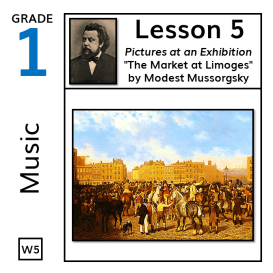
By: Modest Mussorgsky
Week: 5
Each movement within Modest Mussorgsky's 'Pictures at an Exhibition' reflects a picture. Mussorgsky used music to represent himself wandering the halls of a museum and stopping to look at pictures of gnomes, gardens, and markets. It's market day in Limoges, France. Markets are where people regularly gather to buy, sell, and trade goods. Traditional open-air markets are held outside. Listen to the music. Do you think it is a busy day at the market or a slow day? During market day, people often haggle over the price of goods. Haggle means to bargain back and forth, where each side is trying to get the best deal. The seller wants to get the most money, and the buyer wants to pay the least money. Can you hear the haggling in the music? Examine the painting, 'Old Smithfield Market' by Jacques-Laurent Agasse. Does the painting accurately reflect the music? Why or why not? Next week, you might want to grab some torches and cloaks before coming with me to check out the next painting in the museum. Get ready to descend into the darkness beneath a city.
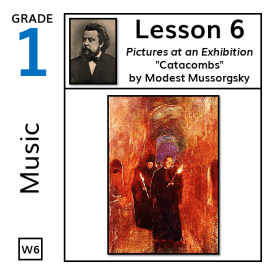
By: Modest Mussorgsky
Week: 6
Each movement within Modest Mussorgsky's 'Pictures at an Exhibition' reflects a picture. Mussorgsky used music to represent himself wandering the halls of a museum and stopping to look at pictures of gnomes, gardens, and markets. Catacombs are underground cemeteries holding the remains of the deceased. The catacombs beneath the city of Paris, France hold the remains of six million people. Listen to the music 'Catacombs' and examine the painting, 'A Procession in the Catacomb of Callistus' by Alberto Pisa. How well do they capture the dark and mysterious ambiance of the catacomb? After our visit to the spooky catacombs, we are in the perfect mood for the next painting, which is both a little scary and a little strange.
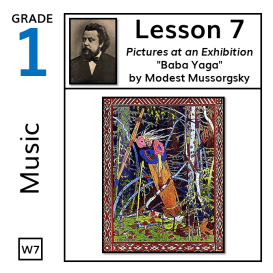
By: Modest Mussorgsky
Week: 7
Each movement within Modest Mussorgsky's 'Pictures at an Exhibition' reflects a picture. Mussorgsky used music to represent himself wandering the halls of a museum and stopping to look at pictures of gnomes, gardens, and markets. Look at the picture 'Baba Yaga' by Ivan Bilibin. Now that is one frightening lady. I wouldn't want her chasing me through the woods at night. In stories, Baba Yaga is a supernatural being who appears as a savage woman. She lives in the forest in a hut that stands on chicken legs. She carries a pestle and rides in a mortar. (The bowl-like mortar and cylinder-like pestle are often made of stone and used to grind things such as herbs.) Listen to the music, and describe how it captures the essence of Baba Yaga. Whew - I think we escaped Baba Yaga unscathed. Let's move to the next painting to view something a little less frightening.
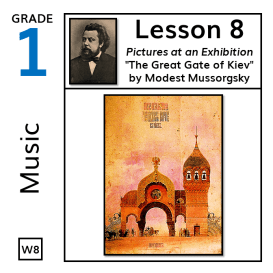
By: Modest Mussorgsky
Week: 8
Each movement within Modest Mussorgsky's 'Pictures at an Exhibition' reflects a picture. Mussorgsky used music to represent himself wandering the halls of a museum and stopping to look at pictures of gnomes, gardens, and markets. The Great Golden Gates of Kiev are in the city of Kiev, Ukraine. Construction started long ago in 1017 and finished seven years later. The gate was taken apart in the Middle Ages and reconstructed in 1982, although no one truly knows what the original gate looked like. Today the gate serves as a museum. Examine the picture 'Plan for a City Gate in Kiev' by Mussorgsky's good friend, Viktor Hartmann. Victor died at the young age of 39. Saddened by his friend's death, Mussorgsky was inspired to compose Pictures at an Exhibition based on artwork created by Viktor. Many of the images were lost to time, but 'Plan for a City Gate in Kiev' survived. Listen to the music, and look at the drawing. How do they relate? Both are massive and grandiose, perhaps even a bit formidable. Do you hear the bell ringing? We have come to the end of our museum tour, but you are welcome to come back and review the artwork and listen to the music anytime. Just watch out for Baba Yaga!
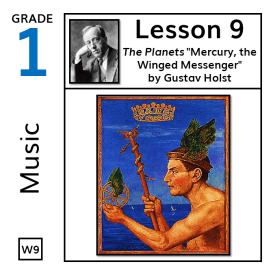
By: Gustav Holst
Week: 9
Gustav Holst's suite, 'The Planets,' contains seven movements that capture the spirit of the seven planets in our solar system, their associated mythological gods, and their astrological signs. Holst composed the suite between 1914 and 1916. Four years before his death, Pluto was discovered and was considered a new planet. But Holst did not want to compose a new work for the new planet (which is no longer considered a planet today). Holst became dismayed with the popularity of this suite, believing it detracted from his other works. The inspiration for this lesson's movement, Mercury, is the smallest planet in our solar system. It is the closest planet to the sun and it is marked with many craters. You would not want to live on Mercury. At its equator, temperatures range from -280 to 800 degrees Fahrenheit which is colder than the coldest temperature ever on Earth and hotter than the highest temperature on your oven. The planet Mercury is named after Mercury, the god of Roman myth who wore winged shoes and a winged hat. He was a god of many things, including messages and making money.
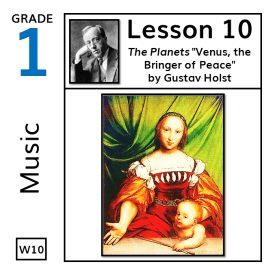
By: Gustav Holst
Week: 10
Gustav Holst's suite, 'The Planets,' contains seven movements that capture the spirit of the seven planets in our solar system, their associated mythological gods, and their astrological signs. Holst composed the suite between 1914 and 1916. Four years before his death, Pluto was discovered and was considered a new planet. But Holst did not want to compose a new work for the new planet (which is no longer considered a planet today). Holst became dismayed with the popularity of this suite, believing it detracted from his other works. The inspiration for this lesson's movement, Venus, is the second closest planet to the sun. You would not want to visit Venus. It is hottest planet in the solar system, has a thick atmosphere that would crush you, and has clouds of sulfuric acid. The planet is named for Venus, the goddess of love and beauty from Roman mythology. Her signs include flowers such as roses and myrtle. Listen to the music, and ponder whether it reminds you more of Venus the planet or Venus the Roman goddess.
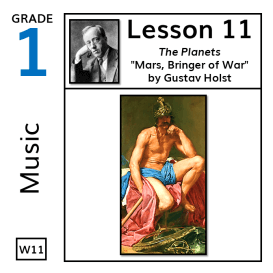
By: Gustav Holst
Week: 11
Gustav Holst's suite, 'The Planets,' contains seven movements that capture the spirit of the seven planets in our solar system, their associated mythological gods, and their astrological signs. Holst composed the suite between 1914 and 1916. Four years before his death, Pluto was discovered and was considered a new planet. But Holst did not want to compose a new work for the new planet (which is no longer considered a planet today). Holst became dismayed with the popularity of this suite, believing it detracted from his other works. Mars is the fourth closest planet to the sun, further out than Earth. Mars is known as the red planet. Its soil is red due to the presence of iron oxide. It is colder on Mars than on Earth, and there is good evidence that Mars has water. Humans have not yet traveled to another planet, but if we do, the planet will likely be Mars. There are current efforts to launch a manned mission to Mars. Temperatures on the Mars equator can reach a comfortable day time temperature of 70 degrees Fahrenheit in the summer. However, even on those relatively balmy days, at night the temperature will plummet back down to negative 100 degrees. Any travelers to Mars will need protection from the cold. The planet is named after Mars, the Roman god of war and agriculture. The Roman god Mars is associated with the woodpecker, the wolf, and the bear. The Roman god Mars is often paired in art with his opposite, Venus, the Roman goddess of love.
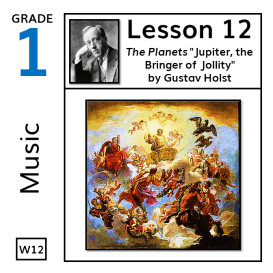
By: Gustav Holst
Week: 12
Gustav Holst's suite, 'The Planets,' contains seven movements that capture the spirit of the seven planets in our solar system, their associated mythological gods, and their astrological signs. Holst composed the suite between 1914 and 1916. Four years before his death, Pluto was discovered and was considered a new planet. But Holst did not want to compose a new work for the new planet (which is no longer considered a planet today). Holst became dismayed with the popularity of this suite, believing it detracted from his other works. Do you remember that Mercury is the smallest planet in our solar system? Jupiter, fifth planet from the sun, is largest. Jupiter is a gas giant, composed mostly of the gases helium (like what is in helium balloons) and hydrogen. Jupiter has a large red spot. Scientists believe the red spot is a storm that has raged for hundreds of years. Can you imagine living in a constant storm that lasts your entire life? You would not want to live on Jupiter. Jupiter probably does not have a solid surface, it is made of a toxic gas, and it is too cold for humans. Faint rings made of tiny rocks and dust encircle Jupiter. The planet is named after Jupiter, the Roman god of sky and thunder. Jupiter is known as the father of all gods and is associated with eagles and thunderbolts (lightening paired with a loud boom of thunder). This movement title includes the word 'Jollity.' Jollity means a lively celebration.
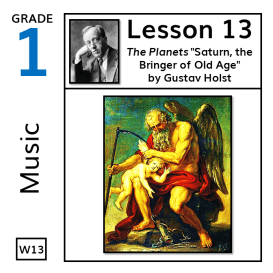
By: Gustav Holst
Week: 13
Gustav Holst's suite, 'The Planets,' contains seven movements that capture the spirit of the seven planets in our solar system, their associated mythological gods, and their astrological signs. Holst composed the suite between 1914 and 1916. Four years before his death, Pluto was discovered and was considered a new planet. But Holst did not want to compose a new work for the new planet (which is no longer considered a planet today). Holst became dismayed with the popularity of this suite, believing it detracted from his other works. Saturn is the second largest planet, after Jupiter. And like Jupiter, it is a gas giant, however the central body of Saturn is encircled by dazzling rings of ice and dust. You would not want to live on Saturn. Saturn probably does not have a solid surface, it is made of a toxic gas, and it is too cold for humans. Did you know that Saturn has 62 moons orbiting around it (Jupiter has 67)? Can you imagine looking up into the heavens at nighttime seeing multiple moons scattered across the black sky? Saturn's largest moon, Titan, is larger than the planet of Mercury. The planet is named after Saturn, the Roman god of time, who is also associated with moving from one year to another. The word 'Saturday' is also derived from this god's name.
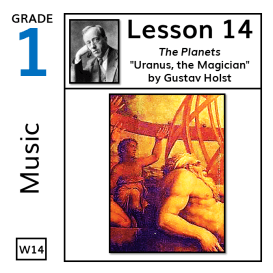
By: Gustav Holst
Week: 14
Gustav Holst's suite, 'The Planets,' contains seven movements that capture the spirit of the seven planets in our solar system, their associated mythological gods, and their astrological signs. Holst composed the suite between 1914 and 1916. Four years before his death, Pluto was discovered and was considered a new planet. But Holst did not want to compose a new work for the new planet (which is no longer considered a planet today). Holst became dismayed with the popularity of this suite, believing it detracted from his other works. Uranus, ice giant and seventh planet from the sun, has a North pole that points toward the sun. Uranus also has rings, although fewer than Saturn. Uranus is a blue color. You would not want to live on Uranus. Uranus probably does not have a solid surface, it is made of ices, and it is too cold for humans. The planet Uranus is named after Uranus, Greek god of the sky. This is the only planet named after a Greek god instead of a Roman god. This piece is more aligned with the Uranus of astrology that rules magic and invention than the Uranus of Greek mythology.
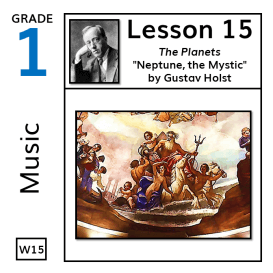
By: Gustav Holst
Week: 15
Gustav Holst's suite, 'The Planets,' contains seven movements that capture the spirit of the seven planets in our solar system, their associated mythological gods, and their astrological signs. Holst composed the suite between 1914 and 1916. Four years before his death, Pluto was discovered and was considered a new planet. But Holst did not want to compose a new work for the new planet (which is no longer considered a planet today). Holst became dismayed with the popularity of this suite, believing it detracted from his other works. Neptune, ice giant and farthest planet from the sun, was found using mathematical calculations rather than observation. You would not want to visit Neptune, because it has sustained winds of 1,300 mph and it is too cold. Neptune has faint rings around it. Like Uranus, Neptune is blue, but it is a brighter blue than Uranus. The planet Neptune is named after Neptune, Roman god of freshwater, the sea, and horses. He is also associated with earthquakes and hurricanes.
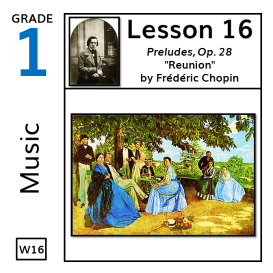
By: Frédéric Chopin
Week: 16
Written between 1835 and 1839, Chopin's 24 Preludes, Op. 28, are a set of short piano compositions. Preludes are short musical pieces that often introduce more complex pieces. When Chopin wrote the Preludes, which are stand-alone versus introducing other pieces, critics criticized them for being too short and lacking structure. Prelude No. 1, 'Reunion,' is marked agitato, which means a restless style. A reunion is a gathering of people who may not see each other often and may typically be separated by great distances. Picture a reunion of a family. A large gathering of parents, grandparents, sisters, brothers, aunts, uncles, and cousins mingle and talk. Children scamper and play.
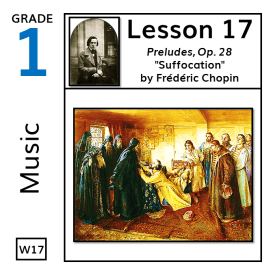
By: Frédéric Chopin
Week: 17
Written between 1835 and 1839, Chopin's 24 Preludes, Op. 28, are a set of short piano compositions. Preludes are short musical pieces that often introduce more complex pieces. When Chopin wrote the Preludes, which are stand-alone versus introducing other pieces, critics criticized them for being too short and lacking structure. Prelude No. 4, 'Suffocation,' was played at Chopin's funeral at his request. It is believed the full title to this piece is 'What tears [are shed] from the depths of the damp monastery?.' You may recognize this piece. It is one of Chopin's best-known.
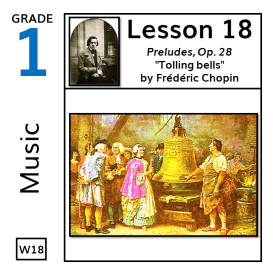
By: Frédéric Chopin
Week: 18
Written between 1835 and 1839, Chopin's 24 Preludes, Op. 28, are a set of short piano compositions. Preludes are short musical pieces that often introduce more complex pieces. When Chopin wrote the Preludes, which are stand-alone versus introducing other pieces, critics criticized them for being too short and lacking structure. Like 'Suffocation,' the prelude, 'Tolling Bells,' was played at Chopin's funeral, which may be the source of the name. A single bell toll is sometimes sounded in remembrance of a person who has passed away.
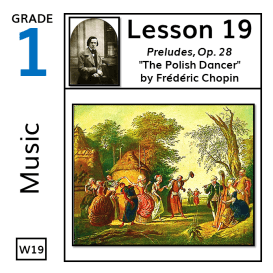
By: Frédéric Chopin
Week: 19
Written between 1835 and 1839, Chopin's 24 Preludes, Op. 28, are a set of short piano compositions. Preludes are short musical pieces that often introduce more complex pieces. When Chopin wrote the Preludes, which are stand-alone versus introducing other pieces, critics criticized them for being too short and lacking structure. Chopin was from Poland, and many of his works were based on traditional Polish dance (mazurkas). You can imagine the precise steps and graceful swirls of dancers as you listen to this prelude.
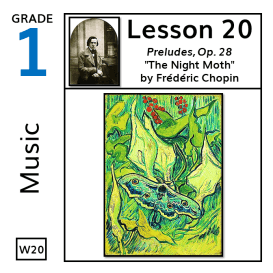
By: Frédéric Chopin
Week: 20
Written between 1835 and 1839, Chopin's 24 Preludes, Op. 28, are a set of short piano compositions. Preludes are short musical pieces that often introduce more complex pieces. When Chopin wrote the Preludes, which are stand-alone versus introducing other pieces, critics criticized them for being too short and lacking structure. Chopin's prelude, 'The Night Moth,' features rapid cascading sequences of notes followed by brief pauses. You can imagine a moth taking flight, rapidly fluttering its wings, and then briefly touching down before taking off again.
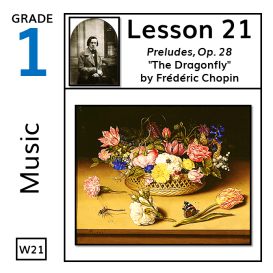
By: Frédéric Chopin
Week: 21
Written between 1835 and 1839, Chopin's 24 Preludes, Op. 28, are a set of short piano compositions. Preludes are short musical pieces that often introduce more complex pieces. When Chopin wrote the Preludes, which are stand-alone versus introducing other pieces, critics criticized them for being too short and lacking structure. Chopin's prelude, 'The Dragonfly,' evokes the joyous feeling of smoothly sailing through the air on a bright sunny day. You can picture a dragonfly soaring and hovering over an idyllic pond.
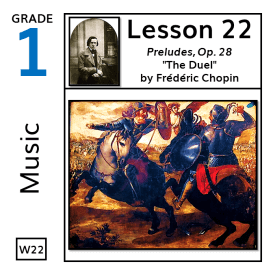
By: Frédéric Chopin
Week: 22
Written between 1835 and 1839, Chopin's 24 Preludes, Op. 28, are a set of short piano compositions. Preludes are short musical pieces that often introduce more complex pieces. When Chopin wrote the Preludes, which are stand-alone versus introducing other pieces, critics criticized them for being too short and lacking structure. You can hear the clashing confrontation in Chopin's prelude, 'The Duel,' and imagine a frantic life-and-death struggle.
By: Frédéric Chopin
Week: 23
Written between 1835 and 1839, Chopin's 24 Preludes, Op. 28, are a set of short piano compositions. Preludes are short musical pieces that often introduce more complex pieces. When Chopin wrote the Preludes, which are stand-alone versus introducing other pieces, critics criticized them for being too short and lacking structure. Chopin's prelude, 'A Pleasure Boat,' flows like rhythmic waves over a peaceful lake.
By: John Philip Sousa
Week: 24
The Gladiator was John Philip Sousa's breakout hit, selling over a million copies. He wrote it in honor of Charles B. Towle, a journalist, either due to an article Towle wrote or perhaps because Towle's pen was 'mightier than the sword.'
By: John Philip Sousa
Week: 25
Regarding 'The Invincible Eagle,' John Philip Sousa stated, 'It is what I call one of my sunshine marches. Some of my heavy marches are intended to convey the impression of the stir and strife of warfare, but The Invincible Eagle shows the military spirit at its lightest and brightest – the parade spirit . . . with the bravery of uniform, the sheen of silken stands, and the gleam of polished steel.' [1]
By: John Philip Sousa
Week: 26
John Philip Sousa wrote 'Manhattan Beach' in honor of the Manhattan Beach Park Hotel in New York City, a lavish beach resort for well-to-do New Yorkers. Sousa both stayed at the hotel and performed his commemorative piece here.
By: John Philip Sousa
Week: 27
American President Chester A. Arthur requested that John Philip Sousa compose 'Presidential Polonaise,' but Arthur died before it was performed. Presidential Polonaise was later used to coax along slow guests as they traversed the receiving line of formal events held at the White House. A Polonaise is a slow dance of Polish origin.
By: Claude Debussy
Week: 28
Claude Debussy's suite, 'La mer' (The Sea), contains three symphonic sketches that capture the unpredictable and turbulent nature of the sea. The first movement, 'From Dawn to Midday on the Sea,' captures the changes in the sea as the sun rises from the horizon to its zenith.
By: Claude Debussy
Week: 29
Claude Debussy's suite, 'La mer' (The Sea), contains three symphonic sketches that capture the unpredictable and turbulent nature of the sea. The second movement, 'Play of Waves,' is brighter and livelier than the first, and may represent the swells of ocean waves on a pleasant day.
By: Claude Debussy
Week: 30
Claude Debussy's suite, 'La mer' (The Sea), contains three symphonic sketches that capture the unpredictable and turbulent nature of the sea. The third movement, 'Dialogue between Wind and Waves,' features the interplay between two forces of nature.
By: Claude Debussy
Week: 31
Inspired by Antoine Watteau's 'The Embarkation for Cythera,' Claude Debussy composed 'L'isle joyeuse' (The Happy Island) for solo piano in 1904.
By: Claude Debussy
Week: 32
Inspired by Stéphane Mallarmé's poem, 'The Afternoon of a Faun,' Debussy's symphonic poem, 'Prelude to the Afternoon of a Faun,' describes the afternoon dreams of a faun, a mythical half-human, half-goat figure.
By: Edvard Grieg
Week: 33
Between 1867 and 1901, Grieg published 66 short solo piano compositions called 'Lyric Pieces.' The pretty 'Drommesyn' (Dream Vision) meanders, like a slow-flowing river on a peaceful day.
By: Edvard Grieg
Week: 34
Between 1867 and 1901, Grieg published 66 short solo piano compositions called 'Lyric Pieces.' Romantic, passionate, and varied in tempo, Grieg's beautiful 'Notturno' (Night) swells with emotion.
By: Edvard Grieg
Week: 35
Between 1867 and 1901, Grieg published 66 short solo piano compositions called 'Lyric Pieces.' Grieg's nostalgic 'In My Homeland,' represents his tenderness for his home country of Norway.
By: Edvard Grieg
Week: 36
Between 1867 and 1901, Grieg published 66 short solo piano compositions called 'Lyric Pieces.' Folk songs are those with specific traditional or regional roots. Grieg often incorporated Norwegian folk songs into his works, as he did with 'Folksong.'